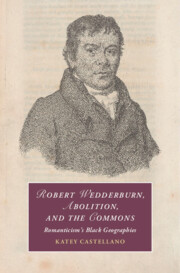Book contents
- Robert Wedderburn, Abolition, and the Commons
- Cambridge Studies in Romanticism
- Robert Wedderburn, Abolition, and the Commons
- Copyright page
- Contents
- Figures
- Acknowledgments
- Introduction
- Chapter 1 Against Private Property
- Chapter 2 From Plantation to Prison
- Chapter 3 Black Women’s Abolitionist Geographies in The Horrors of Slavery and The History of Mary Prince
- Chapter 4 Provisions and Pigs
- Chapter 5 Maroon Settlements as Abolitionist Commons
- Chapter 6 Emancipation as the Enclosure of “Waste Fertility”
- Conclusion
- Notes
- Bibliography
- Index
- Cambridge Studies In Romanticism
Chapter 3 - Black Women’s Abolitionist Geographies in The Horrors of Slavery and The History of Mary Prince
Published online by Cambridge University Press: 09 January 2025
- Robert Wedderburn, Abolition, and the Commons
- Cambridge Studies in Romanticism
- Robert Wedderburn, Abolition, and the Commons
- Copyright page
- Contents
- Figures
- Acknowledgments
- Introduction
- Chapter 1 Against Private Property
- Chapter 2 From Plantation to Prison
- Chapter 3 Black Women’s Abolitionist Geographies in The Horrors of Slavery and The History of Mary Prince
- Chapter 4 Provisions and Pigs
- Chapter 5 Maroon Settlements as Abolitionist Commons
- Chapter 6 Emancipation as the Enclosure of “Waste Fertility”
- Conclusion
- Notes
- Bibliography
- Index
- Cambridge Studies In Romanticism
Summary
Horrors of Slavery announced an abolitionist politics unacknowledged by Romantic-era antislavery activists: place-based, self-liberation initiated and led by Black women. Reworking the abolitionist figure of the sorrowful, enslaved Black mother, Wedderburn celebrated his mother, Rosanna, who demanded that his enslaver father manumit him, and championed his grandmother, Talkee Amy, as a higgler and obeah woman who “trafficked on her own account.” Similar freedom practices are then traced throughout The History of Mary Prince. Prince’s repeated petit marronage demanded enslavers’ acknowledgment of her kinship with her parents and husband. As a higgler, like Talkee Amy, Prince used the produce from the provision grounds to assert freedom in fugitive markets. Wedderburn and Prince’s life narratives brought stories of Black women’s place-based freedom practices to a white audience.
Keywords
- Type
- Chapter
- Information
- Robert Wedderburn, Abolition, and the CommonsRomanticism's Black Geographies, pp. 63 - 80Publisher: Cambridge University PressPrint publication year: 2025

